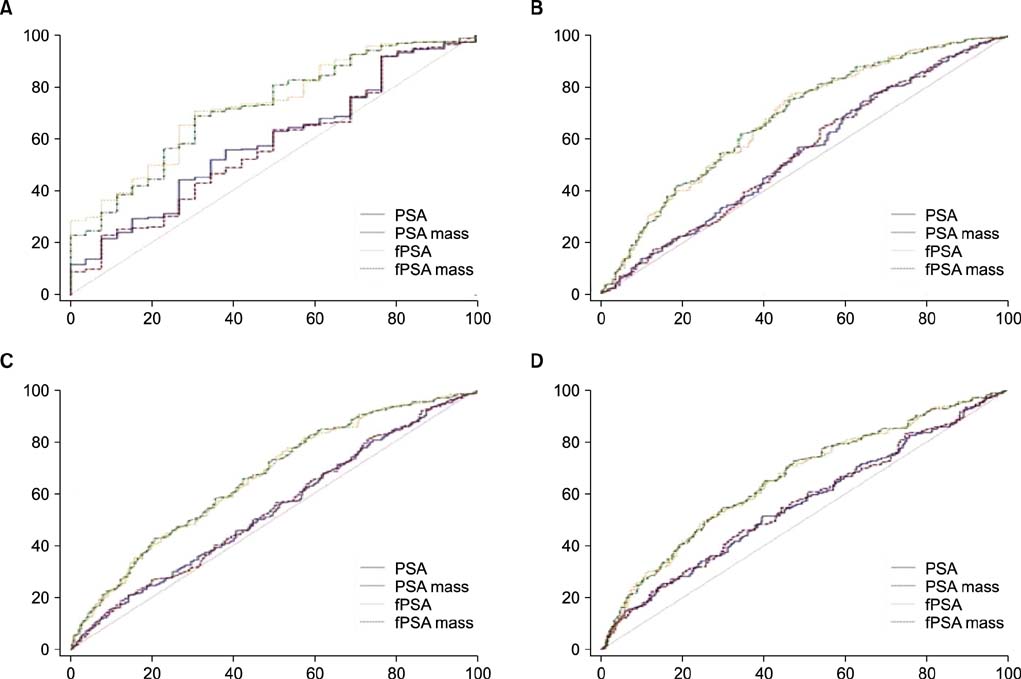Korean J Urol.
2013 Sep;54(9):609-614.
Prostate-Specific Antigen Mass and Free Prostate-Specific Antigen Mass for Predicting the Prostate Volume of Korean Men With Biopsy-Proven Benign Prostatic Hyperplasia
- Affiliations
-
- 1Department of Urology, Korea University Guro Hospital, Seoul, Korea. dgmoon@korea.ac.kr
Abstract
- PURPOSE
It has been reported that prostate-specific antigen (PSA) correlates with prostate volume. Recently, some studies have reported that PSA mass (PSA adjusted for plasma volume) is more accurate than PSA at predicting prostate volume. In this study, we analyzed the accuracy of PSA and the related parameters of PSA mass, free PSA (fPSA), and fPSA mass in predicting prostate volume.
MATERIALS AND METHODS
We retrospectively investigated 658 patients who underwent prostate biopsy from 2006 to 2012 and had a confirmed negative biopsy result. International Prostate Symptom Score (IPSS) questionnaire, PSA, fPSA, and prostate volume were investigated. PSA mass and fPSA mass were calculated by use of established formulas. The association between PSA-related parameters and IPSS and prostate volume was assessed by using Pearson correlation coefficient and receiver operating characteristic curves.
RESULTS
There was no significant difference between PSA and PSA mass, fPSA, or fPSA mass in predicting prostate volume except in obese patients (p-value of PSA-PSA mass for 40 cm3, 0.54; p-value of fPSA-fPSA mass for 40 cm3, 0.34). fPSA performed significantly better than PSA at predicting prostate volume (p-value for 40 cm3, <0.001). IPSS and the aforementioned PSA-related parameters were not significantly correlated.
CONCLUSIONS
PSA mass was not a better predictive value than PSA for estimating the prostate volume in Korean men except in obese men. This finding was also applicable to the relationship of fPSA and fPSA mass, which appeared to be more accurate predictors of prostate volume than either PSA or PSA mass.
MeSH Terms
Figure
Reference
-
1. Jacobsen SJ, Jacobson DJ, Girman CJ, Roberts RO, Rhodes T, Guess HA, et al. Natural history of prostatism: risk factors for acute urinary retention. J Urol. 1997; 158:481–487.2. Roehrborn CG, Boyle P, Gould AL, Waldstreicher J. Serum prostate-specific antigen as a predictor of prostate volume in men with benign prostatic hyperplasia. Urology. 1999; 53:581–589.3. Hochberg DA, Armenakas NA, Fracchia JA. Relationship of prostate-specific antigen and prostate volume in patients with biopsy proven benign prostatic hyperplasia. Prostate. 2000; 45:315–319.4. Kayikci A, Cam K, Kacagan C, Tekin A, Ankarali H. Free prostate-specific antigen is a better tool than total prostate-specific antigen at predicting prostate volume in patients with lower urinary tract symptoms. Urology. 2012; 80:1088–1092.5. Shim HB, Lee JK, Jung TY, Ku JH. Serum prostate-specific antigen as a predictor of prostate volume in Korean men with lower urinary tract symptoms. Prostate Cancer Prostatic Dis. 2007; 10:143–148.6. Chung BH, Hong SJ, Cho JS, Seong DH. Relationship between serum prostate-specific antigen and prostate volume in Korean men with benign prostatic hyperplasia: a multicentre study. BJU Int. 2006; 97:742–746.7. Barqawi AB, Golden BK, O'Donnell C, Brawer MK, Crawford ED. Observed effect of age and body mass index on total and complexed PSA: analysis from a national screening program. Urology. 2005; 65:708–712.8. Bañez LL, Hamilton RJ, Partin AW, Vollmer RT, Sun L, Rodriguez C, et al. Obesity-related plasma hemodilution and PSA concentration among men with prostate cancer. JAMA. 2007; 298:2275–2280.9. Masuda H, Kawakami S, Sakura M, Fujii Y, Koga F, Saito K, et al. Performance of prostate-specific antigen mass in estimation of prostate volume in Japanese men with benign prostate hyperplasia. Int J Urol. 2012; 19:929–935.10. Hong SK, Oh JJ, Byun SS, Hwang SI, Choo MS, Lee SE. Value of prostate-specific antigen (PSA) mass ratio in the detection of prostate cancer in men with PSA levels of ≤10 ng/mL. BJU Int. 2012; 110(2 Pt 2):E81–E85.11. Terris MK, Stamey TA. Determination of prostate volume by transrectal ultrasound. J Urol. 1991; 145:984–987.12. Du Bois D, Du Bois EF. A formula to estimate the approximate surface area if height and weight be known. 1916. Nutrition. 1989; 5:303–311.13. WHO Expert Consultation. Appropriate body-mass index for Asian populations and its implications for policy and intervention strategies. Lancet. 2004; 363:157–163.14. Oelke M, Bachmann A, Descazeaud A, Emberton M, Gravas S, Michel MC, et al. EAU guidelines on the treatment and follow-up of non-neurogenic male lower urinary tract symptoms including benign prostatic obstruction. Eur Urol. 2013; 64:118–140.15. Canto EI, Singh H, Shariat SF, Lamb DJ, Mikolajczyk SD, Linton HJ, et al. Serum BPSA outperforms both total PSA and free PSA as a predictor of prostatic enlargement in men without prostate cancer. Urology. 2004; 63:905–910.16. Chang YL, Lin AT, Chen KK, Chang YH, Wu HH, Kuo JY, et al. Correlation between serum prostate specific antigen and prostate volume in Taiwanese men with biopsy proven benign prostatic hyperplasia. J Urol. 2006; 176:196–199.17. Bohnen AM, Groeneveld FP, Bosch JL. Serum prostate-specific antigen as a predictor of prostate volume in the community: the Krimpen study. Eur Urol. 2007; 51:1645–1652.18. Bryniarski P, Paradysz A, Fryczkowski M. PSA mass as a marker of prostate cancer progression after radical prostatectomy. Med Sci Monit. 2011; 17:CR104–CR109.19. Morote J, Encabo G, Lopez M, de Torres IM. Prediction of prostate volume based on total and free serum prostate-specific antigen: is it reliable? Eur Urol. 2000; 38:91–95.20. Mao Q, Zheng X, Jia X, Wang Y, Qin J, Yang K, et al. Relationships between total/free prostate-specific antigen and prostate volume in Chinese men with biopsy-proven benign prostatic hyperplasia. Int Urol Nephrol. 2009; 41:761–766.
- Full Text Links
- Actions
-
Cited
- CITED
-
- Close
- Share
- Similar articles
-
- The role of serum prostate specific antigen in prostatic cancer and benign prostatic hyperplasia
- The Relationship of Cellular Composition of Benign Prostatic Hyperplasia and Prostate-Specific Antigen (PSA) Levels
- High-Grade Prostatic Intraepithelial Neoplasia
- The relationship among PSA levels, prostatic volume and resected prostate weight
- The Diagnostic Value of Prostate-specific Antigen and the of Routine Laboratory Examination for Early Detection


